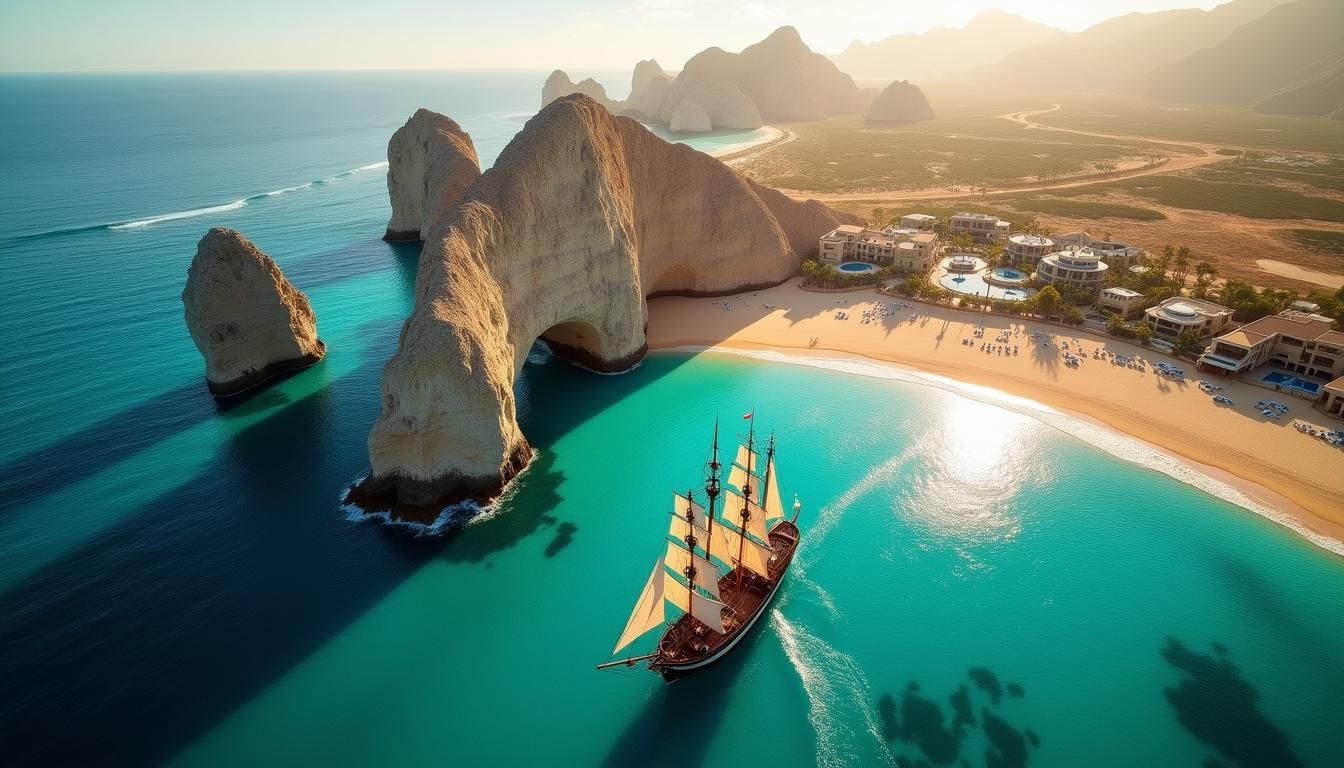
Cabo San Lucas, perched at the southern tip of Mexico’s Baja California Peninsula, is a destination where history whispers through sun-bleached ruins and modern luxury sparkles against desert landscapes. From its days as a pirate hideout to its current status as a playground for the rich and adventurous, Cabo’s story is as dramatic as its iconic rock formations. Let’s dive into the layers of this coastal gem with Mucho Cabo as your guide.
Long before Cabo San Lucas became synonymous with margaritas and infinity pools, it was a strategic outpost for pirates targeting Spanish treasure ships. During the Manila–Acapulco Galleon Trade (1565–1815), Spanish galleons laden with silver from Mexico and silks from Asia sailed perilously close to Cabo’s shores. The area’s jagged coastline—particularly El Arco de Cabo San Lucas, a natural granite arch marking the meeting of the Pacific Ocean and the Gulf of California—provided perfect cover for ambushes.
In 1587, English privateer Thomas Cavendish made history by capturing the Spanish galleon Santa Ana near Cabo. Stripped of its cannons to maximize cargo space, the defenseless ship surrendered a fortune in gold and silver, dealing a devastating blow to Spain’s colonial economy. Other infamous figures like Sir Francis Drake also prowled these waters, cementing Cabo’s reputation as a pirate hotspot.
Today, you can channel this era aboard the Buccaneer Queen, a 96-foot replica pirate ship offering snorkeling excursions and sunset cruises complete with theatrical reenactments of maritime raids.
By the early 20th century, Cabo’s economy revolved around its tuna cannery, established in 1927. For decades, the cannery sustained the local population, but the seeds of tourism were already sprouting. In the 1950s, adventurous anglers began flocking to Cabo for its abundant marlin, tuna, and sailfish. Pioneers like Rod Rodriguez (founder of Rancho Las Cruces) and Bud Parr (who opened the Hotel Cabo San Lucas in 1961) catered to Hollywood elites like John Wayne and Bing Crosby, who sought exclusive sportfishing retreats.
The Transpeninsular Highway, completed in 1973, transformed accessibility. Suddenly, overland travel from the U.S. border was possible, and the Mexican government’s FONATUR (National Fund for Tourism Development) began investing in infrastructure. By the mid-1970s, the marina was dredged, luxury hotels rose along the coast, and Cabo’s identity as a tourist hub solidified.
The 1990s marked Cabo’s pivot toward high-end tourism. Jack Nicklaus-designed golf courses, such as Cabo del Sol, lured affluent travelers, while resorts like Las Ventanas al Paraíso (opened in 1997) redefined luxury with private plunge pools and personalized butler service. The Tourist Corridor, a 20-mile stretch between Cabo San Lucas and San José del Cabo, became a ribbon of opulence, dotted with beachfront villas, spas, and celebrity-owned estates.
In 2023, Cabo welcomed 3.86 million visitors, drawn by direct flights from over 30 U.S. cities and amenities like yacht charters, gourmet dining, and wellness retreats. The average hotel rate now exceeds $500 per night, reflecting its status as a bucket-list destination.
Cabo’s history isn’t just confined to textbooks—it’s etched into its landscape:
Cabo’s rapid development hasn’t been without challenges. The tourism boom has strained water resources, with luxury golf courses and resorts consuming vast amounts of water while nearby communities face shortages. Recent initiatives aim to promote sustainable tourism, including desalination plants and stricter regulations on construction. Organizations are also working to preserve Cabo Pulmo’s coral reefs, a UNESCO World Heritage Site, through eco-friendly diving tours.
Cabo San Lucas is a place of contradictions: rugged desert meets turquoise sea, pirate legends mingle with Michelin-starred dining, and ancient traditions coexist with modern indulgence. At Mucho Cabo, we’re passionate about uncovering these layers—whether you’re sipping mezcal at a beachside bar, exploring colonial architecture, or diving into pirate lore.
So pack your sense of adventure. The soul of Cabo awaits.
[Sources: loscabosguide.com, mexiconewsdaily.com, en.wikipedia.org, elpais.com]
